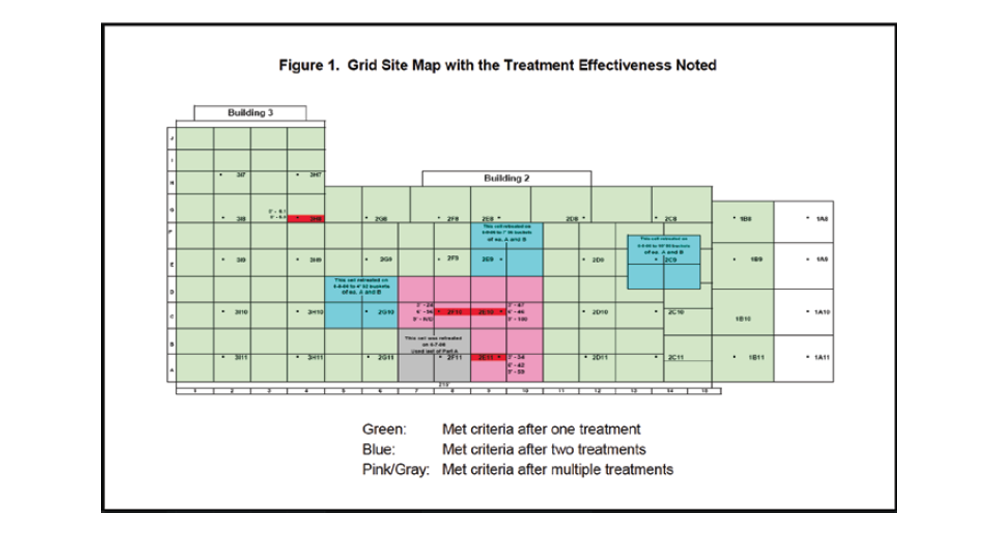RegenOx® Technology Expedites Hollywood Brownfield Site Transaction
Project Highlights
- Reduction of TCE, naphthalene, and styrene levels to below risk-based closure levels via in situ chemical oxidation clears the way for property sale
- Flexibility of RegenOx® application allowed the remediation to be completed faster and more effectively
- Treatment of over 18,000 cubic yards of vadose soil completed within 30 days

Project Summary
A pending real estate transaction of a industrial property in Hollywood, CA was held up by contamination of the vadose zone with a mixture of chlorinated and petroleum solvents. Before the transaction could be finalized, high levels of perchloroethene (PCE), naphthalene, and styrene in the vadose zone soil had to be reduced to below risk-based closure levels. To achieve this, the engineering firm in charge of remediation selected chemical oxidation using RegenOx based on the product’s proven effectiveness, low-cost, and handling safety.

Direct-Push Injection
A remediation plan was developed for the contaminated site that involved two rounds of direct-push application of RegenOx separated by 4 to 6 weeks. The direct-push methodology uses specialized equipment to apply RegenOx to discrete areas of the subsurface without soil removal (i.e., in situ). In order to determine the effectiveness of the treatment, composite soil samples from various grid cells were taken before and after application of RegenOx. Before treatment, significant variation was seen in the contaminant concentrations, with maximum concentrations of 140 μg/kg for PCE, 1200 μg/kg for naphthalene, and 400 μg/kg for styrene. Following the first direct-push application of RegenOx, the average PCE concentration was reduced to 4 μg/kg, a decrease of 86%. Similar results were seen for the petroleum solvents and other chlorinated volatile organic compounds (cVOCs) in the composite soil samples.
Soil Mixing Applicationhollywood2
Despite the contaminant reductions achieved by the first direct-push application of RegenOx, REGENESIS® Remediation Services determined that the speed and effectiveness of the remediation effort could be significantly improved by switching to soil mixing application of RegenOx. In this more aggressive approach, RegenOx was mechanically blended into the vadose soil in order to maximize the contact between the product and the contaminated soil. RegenOx was added as an eight percent solution and mixed throughout the soil using soil mixing equipment. With this treatment method, approximately twice as much soil was treated per day compared to direct-push application.
Of the 111 grids treated with RegenOx by soil mixing (Figure 1), 83 required only one treatment (green) to achieve levels below risk-based closure, 12 required two treatments (blue), and 16 required more than two treatments (pink and gray).

Technology Description
RegenOx is a percarbonate-based in situ chemical oxidation technology that rapidly destroys petroleum hydrocarbons and chlorinated contaminants through powerful chemical reactions. It directly oxidizes contaminants while a catalytic component generates oxidizing free radicals to destroy the target compounds.
Results
The mixed chlorinated and petroleum solvent contamination of the vadose soil was effectively reduced using RegenOx in both direct-push and soil mixing applications. Soil mixing was used to complete the remediation effort rather than a second round of direct-push injections because it maximized contact between RegenOx and the contaminated soil, achieving more rapid and effective treatment. In 74% of the treatment grids, concentrations of all the contaminants were reduced below the risk-based cleanup goal with a single application by soil mixing. Additional applications in the remaining 26% of the treatment grids also achieved the targeted levels for all the contaminants. This remediation approach successfully treated nearly 18,000 cubic yards of soil within 30 days. Using RegenOx and flexible application methods, the site was quickly and effectively remediated, allowing for the real estate transaction to be completed.

 Americas
Americas Europe
Europe Français
Français Deutsch
Deutsch Italiano
Italiano Español
Español



